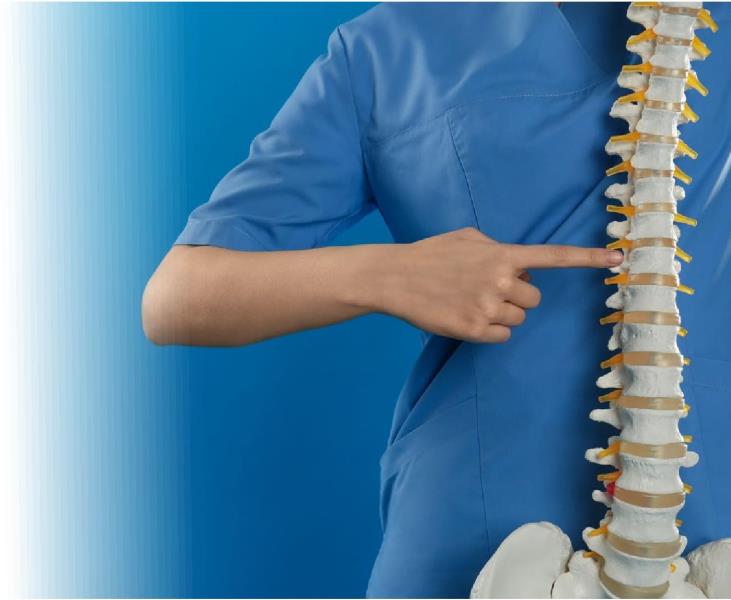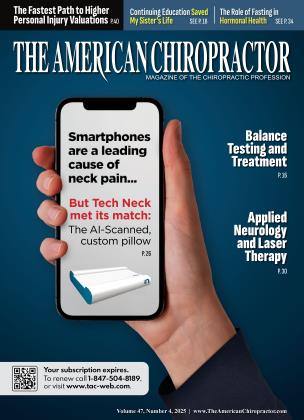
“I am writing this article to encourage my colleagues to have a thorough spinal and nervous system examination with a chiropractor and follow their recommendations”
I’M EXCITED TO SHARE THE IMPORTANCE OF REGULAR CHIROPRACTIC CARE WITH YOU. This holistic approach to health offers numerous benefits for overall wellness and physiological function, backed by research and our institution’s commitment to chiropractic education. From my experience as a chiropractic patient for the past 57 years and as a chiropractor for 45 years, chiropractic care is so much more than just addressing back or neck pain. It’s a comprehensive approach to health that maintains normal neural and physiological function.
Regular adjustments (as necessary) lead to improved spinal and neurological health, which is crucial to overall health and well-being. When your spine is properly aligned, it allows for better nerve function, better brain function, and better organic function. I will assume that every chiropractor reading this will agree and probably say, “This is so basic.”
So I ask you, dear colleagues, do you consistently check your patients for vertebral subluxations and correct them when necessary? Do you have a chiropractor do that for you?
Based on results when asking this question from various stages where I’ve had the honor to speak, chiropractors do that for others and forget to do it for themselves. Years ago, that was me. I got checked by DC friends, but I was not a patient of any practice, and it almost took my life.
In 2003, I was diagnosed with primary pulmonary hypertension (PPH) with pulmonary pressure measured at 57mm HG and a secondary diagnosis of cardiomegaly measured at 2.5x. Medicine gave me the option to have a double lung and heart transplant, or I would likely be dead within 24 months. I was unwilling to have the surgery, so I retired from practice and prepared myself for the ultimate transition.
Thirty-one days after my retirement, I had an epiphany. Maybe there was something “wrong” with my spine and nervous system. What a concept! And, of course, there was, from C7 to T-4.
I started getting regular adjustments, and within three months, my pulmonary pressure was 27mm HG and normal within one year. My cardiomegaly also completely reversed in 24 months.
I am writing this article to encourage my colleagues to have a thorough spinal and nervous system examination with a chiropractor and follow their recommendations. Fully embrace the chiropractic lifestyle for the rest of your life. I am healthier at 70 years young than I was at 48 in 2003, and I see my chiropractor weekly.
Recent research has shed light on the fascinating connection between chiropractic adjustments and brain function. A study published in the Journal of Neural Plasticity, led by Dr. Heidi Haavik, has shown that chiropractic adjustments can improve brain function by more than 20%, particularly in the prefrontal cortex. This area of the brain is responsible for higher learning, cognition, and sensorimotor control.
The study demonstrates that spinal function directly impacts brain function, providing scientific evidence for what many chiropractors have observed in their patients. After receiving chiropractic adjustments, people often report feeling more focused and experiencing improved thinking, attention, and behavior.1,2
Recent research published in the Nature Journal has shown that cervical lordosis directly correlates with how well the spinal cord functions in terms of synapses. A misaligned spine can lead to slower processing of stimuli.3,4
A study published in the Journal of Neurosurgery titled “Cervical Spine Alignment, Sagittal Deformity, and Clinical Implications,” stated that a decrease in cervical lordosis had a direct impact on health-related quality of life. Yes, subluxations affect people’s overall health.5
Despite its many benefits, chiropractic care is sometimes misunderstood. One common misconception is that chiropractic care is only for back pain. In reality, chiropractic care can address a wide range of health issues and contribute to overall wellness.
Regular adjustments can help prevent injuries, reduce stress, improve mobility and balance, and even boost immunity. Another misconception is that chiropractic adjustments are painful or dangerous. In fact, when performed by a skilled practitioner, chiropractic adjustments are safe.
At Life University, we’re dedicated to advancing chiropractic care through education and research. Our mission is to educate, mentor, and graduate contemporary and compassionate doctors of chiropractic, based on a model of vertebral subluxation.
We strive to embody vitalism and nurture integrity in our students, preparing them to make a positive impact in the world through chiropractic care. Our curriculum focuses on the relationship between the structure and function of the human body as coordinated by the nervous system and the effects of vertebral subluxation. We instill in our graduates an appreciation for the body’s innate potential to heal and adapt and the crucial role of the nervous system in maintaining and enhancing human health.
In conclusion, regular chiropractic care offers a multitude of benefits for overall health and wellness. From improving spinal health and relieving pain to enhancing brain and neurological function, chiropractic adjustments play a vital role in maintaining optimal health. As we continue to uncover new research supporting the efficacy of chiropractic care, it’s clear that this holistic approach to health has much to offer in our quest for wellness and vitality.
Please, fellow colleagues, practice what you preach and experience your body’s ability to be self-maintaining and self-healing.

Dr. Gilles LaMarche is a chiropractor, author, professional speaker, and certified personal development/executive coach. Inspired by his own healing journey as a child, he has spent over 40 years promoting health and personal responsibility. A passionate advocate for success, he authored The ART of Being Healthy series and is working on his book You Were Born to Thrive. Gilles balances a successful career with a fulfilling personal life, deeply committed to helping others achieve their full potential through mind, body, and spirit.
1. Haavik H, Kumari N, Holt K, Niazi IK, Amjad I, Pujari AN, Tiirker KS, Murphy B. The contemporary model of vertebral column joint dysfunction and impact of high-velocity, low-amplitude controlled vertebral thrusts on neuromuscular function. Eur J Appl Physiol. 2021 Oct;121(10):2675-2720. doi: 10.1007/ s00421-021-04727-z. Epub 2021 Jun 23. PMID: 34164712; PMCID: PMC8416873.
2. Niazi IK, Navid MS, Merkle C, Amjad I, Kumari N, Trager RJ, Holt K, Haavik H. A randomized controlled trial comparing different sites of high-velocity low amplitude thrust on sensorimotor integration parameters. Sci Rep. 2024 Jan 12;14(1):1159. doi: 10.1038/s41598024-51201-9. PMID: 38216596; PMCID: PMC10786886.
3. https://www.thespinejournalonl... article/S 1529-943 0( 13)01031 -O/abstract
4. Protopsaltis TS, Scheer JK, Terran JS, Smith JS, Hamilton DK, Kim HJ, Mundis GM Jr, Hart RA, McCarthy IM, Klineberg E, Lafage V, Bess S, Schwab F, Shaffrey CI, Ames CP; International Spine Study Group. How the neck affects the back: changes in regional cervical sagittal alignment correlate to HRQOL improvement in adult thoracolumbar deformity patients at 2-year follow-up. J Neurosurg Spine. 2015 Aug;23(2): 153-8. doi: 10.3171/2014.11. SPINE1441. Epub 2015 May 15. PMID: 25978077.
5. Scheer JK, Tang J A, Smith JS, Acosta FL Jr, Protopsaltis TS, Blondel B. Bess S, Shaffrey CI, Deviren V, Lafage V, Schwab F, Ames CP; International Spine Study Group. Cervical spine alignment, sagittal deformity, and clinical implications: a review. J Neurosurg Spine. 2013 Aug;19(2): 141-59. doi: 10.3171/2013.4.SPINE12838. Epub 2013 Jun 14. PMID: 23768023.
 View Full Issue
View Full Issue









